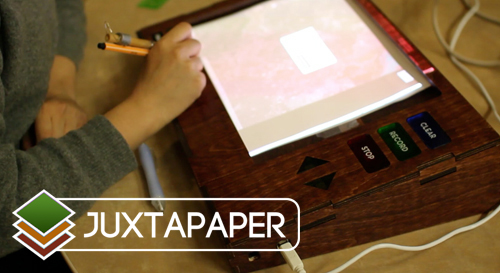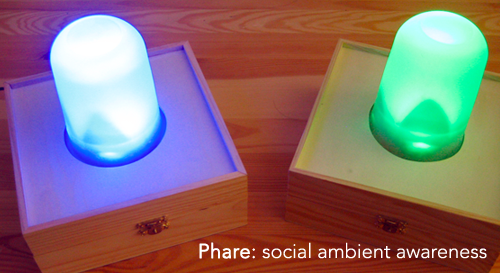-
Turn to Clear Vision
September 2012 - On the pier of San Francisco, coin-operated binoculars and telescopes stand waiting for visitors to peer through and "bring distant objects of interest within close range". As part of the Urban Prototyping Makeathon 6 strangers, I among them, reimagined this scenario by asking ourselves what it would be like if the object the viewer saw was not the thing the telescope was pointed at. Watch the video, read about it on Wired or check out the website.
-
MuseumTag
March 2012 - After several weeks of needfinding and prototyping iterations, our d.school d.science team condensed our findings into "Museum aficionados need a way to keep track of exhibits they have interacted with at different museums because over time these experiences "become a blur"" and we developed prototypes around that point of view. View our final presentation or visit the website
-
Juxtapaper
March 2012 - Many online activities that involve multiple steps, interpretation and analysis are confined to a virtual medium. Juxtapaper is a novel system that aims to bridge the physical/virtual divide by encouraging ownership of paper. Watch the video, read the report or check out the website.
-
Musical Stairs
August 2011 - As a prank during our internship, we hacked together a musical stair using IR sensors and Arduinos. Assembly took about two weeks and the final product contains a track for piano sounds as well as clapping sounds. Watch the video, read the build log or see it on SparkFun
-
Pinolio
September 2011 - Pinolio is a web-based software application that lets users make professional, customized web-bookmarks. Visit the website
-
Phare
May 2011 - Phare is an ambient awareness globe made using frosted glass and Arduino Unos. It lets people communicate presence using wireless Internet-based communication - the first implementation used breathing and respiration from pairs of participants.
-
Synconnect
March - May 2011 - Synconnect was an in-depth research project in human-computer interaction that considered the design space of online collaboration using a virtual ambient tool. A small desktop application for MacOS was developed to help signal partners on their engagement in a collaborative Google Docs task. Find out more
-
Notely
January - March 2011 - Notely lets you leave virtual notes everywhere you go. Share experiences and memories, thoughts and reflections. Notely was selected to present at Stanford's first iOS App Showcase during the spring of 2011 and was also one of five selected class finalists. Check it out
-
TwitterDots
January - May 2011 - TwitterDots maps recent tweets containing certain keywords to geographic locations using the Twitter Streaming API and a custom-coded geocoder. It was presented at HackDemocracy in San Francisco, the SF Data Visualization meetup group, as well as WhereCamp 2011. It was featured in infosthetics. Try it out or watch the talk (starting at 43:40)
-
WebEye
March 2011 - The transfer of information from a computer to a mobile device is often relatively tedious, involving emails or typing long URLs. Current optical character recognition technology is relatively limited, but sufficient for simple things such as URLs. I developed an iPhone app that lets people snap photos of a URL and launch the resulting page. See the prototype
-
justnear.me
January 2011 - - justnear.me is a social data content delivery platform based around QR codes. It was launched as a startup in March of 2011 and presented at Stanford BASES Product Showcase and WhereCamp 2011. It has since been adopted as part of a Stanford MS&E class curriculum on social data use. The service was discontinued in January of 2012. Check it out
-
SeeMyHistory
February 2011 - - How might we encourage awareness in an activity we do almost automatically, every day? Using a mobile phone and tasked with using just color for representation, we developed an Android wallpaper application and companion webpage that lets people see their own browser history in terms of mood. Check it out
-
Respeak
January 2011 - Respeak.me was the winner at the January Mashery Hackathon in San Francisco. It is a simple web application that lets people record messages with the simple press of a button, and have that same message saved and sent via email immediate or shared via Facebook or Twitter. Check it out
-
Protoviewer
October - December 2010 - Protovis is a SVG-based JavaScript tool for rendering beautiful visualizations online. Protoviewer is an online visual design environment developed in order to facilitate development of visualizations, incorporating bug detection, automatic rendering, and visualization recommendations. The poster was accepted into SIGCHI 2011. Check it out
-
Foreign Accented Speech Transcription
September - March 2009 - Automated speech transcription systems have a particularly difficult time transcribing speech from those who have foreign accents. Using a combination of the CSLU Foreign Accented Speech corpus and the George Mason University speech accent archive, I developed a Facebook game that would let individuals transcribe such speech in a fun and entertaining setting. The recordings are of foreign nationals speaking English or reading an English passage. Check it out















